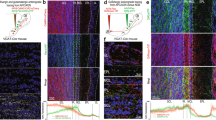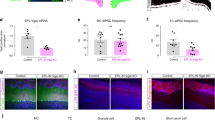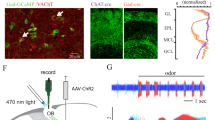Abstract
Centrifugal serotonergic fibers innervate the olfactory bulb, but the importance of these projections for olfactory processing is unclear. We examined serotonergic modulation of sensory input to olfactory glomeruli using mice that express synaptopHluorin in olfactory receptor neurons (ORN). Odor-evoked synaptic input to glomeruli was attenuated by increased serotonin signaling through serotonin 2C (5-HT2C) receptors and amplified by decreased serotonergic activity. Intravital multiphoton calcium imaging revealed that 5-HT2C receptor activation amplified odor-evoked activity in a subset of juxtaglomerular cells and attenuated glutamate release from ORN terminals via GABAB receptors. Endogenous serotonin released by electrical stimulation of the dorsal raphe nucleus attenuated odor-evoked responses without detectable bias in glomerular position or odor identity. Weaker glomerular responses, however, were less sensitive to raphe stimulation than strong responses. Our data indicate that the serotonergic system regulates odor inputs in the olfactory bulb and suggest that behavioral states may alter odor processing at the earliest stages.
This is a preview of subscription content, access via your institution
Access options
Subscribe to this journal
Receive 12 print issues and online access
$209.00 per year
only $17.42 per issue
Buy this article
- Purchase on Springer Link
- Instant access to full article PDF
Prices may be subject to local taxes which are calculated during checkout






Similar content being viewed by others
References
Jacobs, B.L. & Azmitia, E.C. Structure and function of the brain serotonin system. Physiol. Rev. 72, 165–229 (1992).
Hurley, L.M., Devilbiss, D.M. & Waterhouse, B.D. A matter of focus: monoaminergic modulation of stimulus coding in mammalian sensory networks. Curr. Opin. Neurobiol. 14, 488–495 (2004).
Jacobs, B.L. & Fornal, C.A. 5-HT and motor control: a hypothesis. Trends Neurosci. 16, 346–352 (1993).
Daw, N.D., Kakade, S. & Dayan, P. Opponent interactions between serotonin and dopamine. Neural Netw. 15, 603–616 (2002).
McLean, J.H. & Shipley, M.T. Serotonergic afferents to the rat olfactory bulb. I. Origins and laminar specificity of serotonergic inputs in the adult rat. J. Neurosci. 7, 3016–3028 (1987).
McLean, J.H. & Shipley, M.T. Serotonergic afferents to the rat olfactory bulb. II. Changes in fiber distribution during development. J. Neurosci. 7, 3029–3039 (1987).
Aungst, J.L. & Shipley, M.T. Periglomerular cells in mouse olfactory bulb glomeruli: serotonergic modulation. Soc. Neurosci. Abstr. 739.10 (2005).
Hardy, A., Palouzier-Paulignan, B., Duchamp, A., Royet, J.P. & Duchamp-Viret, P. 5-Hydroxytryptamine action in the rat olfactory bulb: in vitro electrophysiological patch-clamp recordings of juxtaglomerular and mitral cells. Neuroscience 131, 717–731 (2005).
Miesenböck, G., De Angelis, D.A. & Rothman, J.E. Visualizing secretion and synaptic transmission with pH-sensitive green fluorescent proteins. Nature 394, 192–195 (1998).
Bozza, T., McGann, J.P., Mombaerts, P. & Wachowiak, M. In vivo imaging of neuronal activity by targeted expression of a genetically encoded probe in the mouse. Neuron 42, 9–21 (2004).
Soucy, E.R., Albeanu, D.F., Fantana, A.L., Murthy, V.N. & Meister, M. Precision and diversity in an odor map on the olfactory bulb. Nat. Neurosci. 12, 210–220 (2009).
McLean, J.H., Darby-King, A. & Paterno, G.D. Localization of 5-HT2A receptor mRNA by in situ hybridization in the olfactory bulb of the postnatal rat. J. Comp. Neurol. 353, 371–378 (1995).
Pompeiano, M., Palacios, J.M. & Mengod, G. Distribution and cellular localization of mRNA coding for 5-HT1A receptor in the rat brain: correlation with receptor binding. J. Neurosci. 12, 440–453 (1992).
Boothman, L., Raley, J., Denk, F., Hirani, E. & Sharp, T. In vivo evidence that 5-HT(2C) receptors inhibit 5-HT neuronal activity via a GABAergic mechanism. Br. J. Pharmacol. 149, 861–869 (2006).
Parrish-Aungst, S., Shipley, M.T., Erdelyi, F., Szabo, G. & Puche, A.C. Quantitative analysis of neuronal diversity in the mouse olfactory bulb. J. Comp. Neurol. 501, 825–836 (2007).
Wachowiak, M. et al. Inhibition of olfactory receptor neuron input to olfactory bulb glomeruli mediated by suppression of presynaptic calcium influx. J. Neurophysiol. 94, 2700–2712 (2005).
Wachowiak, M. & Shipley, M.T. Coding and synaptic processing of sensory information in the glomerular layer of the olfactory bulb. Semin. Cell Dev. Biol. 17, 411–423 (2006).
Petzold, G.C., Albeanu, D.F., Sato, T.F. & Murthy, V.N. Coupling of neural activity to blood flow in olfactory glomeruli is mediated by astrocytic pathways. Neuron 58, 897–910 (2008).
McGann, J.P. et al. Odorant representations are modulated by intra- but not interglomerular presynaptic inhibition of olfactory sensory neurons. Neuron 48, 1039–1053 (2005).
Pírez, N. & Wachowiak, M. In vivo modulation of sensory input to the olfactory bulb by tonic and activity-dependent presynaptic inhibition of receptor neurons. J. Neurosci. 28, 6360–6371 (2008).
Gurden, H., Uchida, N. & Mainen, Z.F. Sensory-evoked intrinsic optical signals in the olfactory bulb are coupled to glutamate release and uptake. Neuron 52, 335–345 (2006).
Brodin, E. et al. In vivo release of serotonin in cat dorsal vagal complex and cervical ventral horn induced by electrical stimulation of the medullary raphe nuclei. Brain Res. 535, 227–236 (1990).
Glass, J.D., DiNardo, L.A. & Ehlen, J.C. Dorsal raphe nuclear stimulation of SCN serotonin release and circadian phase-resetting. Brain Res. 859, 224–232 (2000).
Hajós-Korcsok, E. & Sharp, T. Electrical stimulation of the dorsal and median raphe nuclei increases extracellular noradrenaline in rat hippocampus: Evidence for a 5-HT-independent mechanism. Pharmacol. Biochem. Behav. 71, 807–813 (2002).
Shea, S.D., Katz, L.C. & Mooney, R. Noradrenergic induction of odor-specific neural habituation and olfactory memories. J. Neurosci. 28, 10711–10719 (2008).
Aghajanian, G.K. & Marek, G.J. Serotonin model of schizophrenia: emerging role of glutamate mechanisms. Brain Res. Brain Res. Rev. 31, 302–312 (2000).
Zhang, X. et al. Loss-of-function mutation in tryptophan hydroxylase-2 identified in unipolar major depression. Neuron 45, 11–16 (2005).
Dacks, A.M., Christensen, T.A. & Hildebrand, J.G. Modulation of olfactory information processing in the antennal lobe of Manduca sexta by serotonin. J. Neurophysiol. 99, 2077–2085 (2008).
Rhoades, R.W., Bennett-Clarke, C.A., Shi, M.Y. & Mooney, R.D. Effects of 5-HT on thalamocortical synaptic transmission in the developing rat. J. Neurophysiol. 72, 2438–2450 (1994).
Chen, C. & Regehr, W.G. Presynaptic modulation of the retinogeniculate synapse. J. Neurosci. 23, 3130–3135 (2003).
Hayar, A., Karnup, S., Ennis, M. & Shipley, M.T. External tufted cells: a major excitatory element that coordinates glomerular activity. J. Neurosci. 24, 6676–6685 (2004).
Hayar, A., Shipley, M.T. & Ennis, M. Olfactory bulb external tufted cells are synchronized by multiple intraglomerular mechanisms. J. Neurosci. 25, 8197–8208 (2005).
Olsen, S.R. & Wilson, R.I. Lateral presynaptic inhibition mediates gain control in an olfactory circuit. Nature 452, 956–960 (2008).
Aungst, J.L. et al. Centre-surround inhibition among olfactory bulb glomeruli. Nature 426, 623–629 (2003).
Bloom, F.E., Costa, E. & Salmoiraghi, G.C. Analysis of individual rabbit olfactory bulb neuron responses to the microelectrophoresis of acetylcholine, norepinephrine and serotonin synergists and antagonists. J. Pharmacol. Exp. Ther. 146, 16–23 (1964).
Von Baumgarten, R., Bloom, F.E., Oliver, A.P. & Salmoiraghi, G.C. Response of individual olfactory nerve cells to microelectrophoretically administered chemical substances. Pflugers Arch. 277, 125–140 (1963).
McLean, J.H., Darby-King, A. & Hodge, E. 5-HT2 receptor involvement in conditioned olfactory learning in the neonate rat pup. Behav. Neurosci. 110, 1426–1434 (1996).
Langdon, P.E., Harley, C.W. & McLean, J.H. Increased beta adrenoceptor activation overcomes conditioned olfactory learning deficits induced by serotonin depletion. Brain Res. Dev. Brain Res. 102, 291–293 (1997).
Jacobs, B.L. & Fornal, C.A. Activity of brain serotonergic neurons in the behaving animal. Pharmacol. Rev. 43, 563–578 (1991).
Waterhouse, B.D., Devilbiss, D., Seiple, S. & Markowitz, R. Sensorimotor-related discharge of simultaneously recorded, single neurons in the dorsal raphe nucleus of the awake, unrestrained rat. Brain Res. 1000, 183–191 (2004).
Kepecs, A., Uchida, N. & Mainen, Z.F. Rapid and precise control of sniffing during olfactory discrimination in rats. J. Neurophysiol. 98, 205–213 (2007).
Verhagen, J.V., Wesson, D.W., Netoff, T.I., White, J.A. & Wachowiak, M. Sniffing controls an adaptive filter of sensory input to the olfactory bulb. Nat. Neurosci. 10, 631–639 (2007).
Mainen, Z.F. Single unit correlates of decision-making in the dorsal raphe of the rat. Soc. Neurosci. Abstr. 541.3 (2007).
Albeanu, D.F., Soucy, E., Sato, T.F., Meister, M. & Murthy, V.N. LED arrays as cost effective and efficient light sources for widefield microscopy. PLoS One 3, e2146 (2008).
Baumann, M.H., Ayestas, M.A., Dersch, C.M. & Rothman, R.B. 1-(m-chlorophenyl)piperazine (mCPP) dissociates in vivo serotonin release from long-term serotonin depletion in rat brain. Neuropsychopharmacology 24, 492–501 (2001).
Best, A.R. & Regehr, W.G. Serotonin evokes endocannabinoid release and retrogradely suppresses excitatory synapses. J. Neurosci. 28, 6508–6515 (2008).
Dremencov, E. et al. Hyperfunctionality of serotonin-2C receptor–mediated inhibition of accumbal dopamine release in an animal model of depression is reversed by antidepressant treatment. Neuropharmacology 48, 34–42 (2005).
Günther, S., Maroteaux, L. & Schwarzacher, S.W. Endogenous 5-HT2B receptor activation regulates neonatal respiratory activity in vitro. J. Neurobiol. 66, 949–961 (2006).
Lalley, P.M. The excitability and rhythm of medullary respiratory neurons in the cat are altered by the serotonin receptor agonist 5-methoxy-N,N, dimethyltryptamine. Brain Res. 648, 87–98 (1994).
Westerink, B.H. & De Vries, J.B. A method to evaluate the diffusion rate of drugs from a microdialysis probe through brain tissue. J. Neurosci. Methods 109, 53–58 (2001).
Acknowledgements
We thank T. Sato for writing data acquisition and analysis software for all the microscopy, G. Szabo for the GAD65-GFP mice and the members of the Murthy laboratory for numerous discussions. This work was supported in part by the Marie Curie Fellowship Program of the European Union (G.C.P.).
Author information
Authors and Affiliations
Contributions
G.C.P. and V.N.M. conceived the project. G.C.P. and A.H. conducted the experiments. G.C.P. and V.N.M. analyzed the data and wrote the manuscript.
Corresponding authors
Supplementary information
Supplementary Text and Figures
Supplementary Figures 1 and 2 and Supplementary Table 1 (PDF 101 kb)
Rights and permissions
About this article
Cite this article
Petzold, G., Hagiwara, A. & Murthy, V. Serotonergic modulation of odor input to the mammalian olfactory bulb. Nat Neurosci 12, 784–791 (2009). https://doi.org/10.1038/nn.2335
Received:
Accepted:
Published:
Issue Date:
DOI: https://doi.org/10.1038/nn.2335
This article is cited by
-
5-HT2C receptor perturbation has bidirectional influence over instrumental vigour and restraint
Psychopharmacology (2022)
-
Hyposmia may predict development of freezing of gait in Parkinson’s disease
Journal of Neural Transmission (2021)
-
Extrinsic neuromodulation in the rodent olfactory bulb
Cell and Tissue Research (2021)
-
Pro-neurogenic effect of fluoxetine in the olfactory bulb is concomitant to improvements in social memory and depressive-like behavior of socially isolated mice
Translational Psychiatry (2020)
-
Cortical Organization of Centrifugal Afferents to the Olfactory Bulb: Mono- and Trans-synaptic Tracing with Recombinant Neurotropic Viral Tracers
Neuroscience Bulletin (2019)



